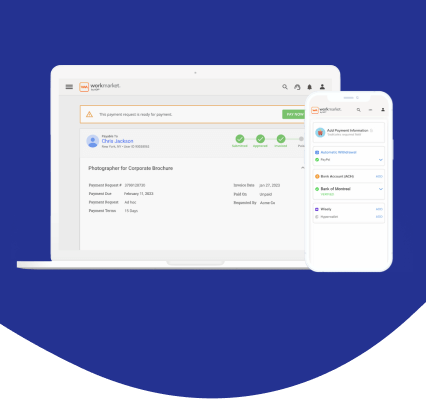Contingent workers, also known as independent contractors or 1099 workers, are people who lend their skills and expertise to a business on a project-by-project or short-term basis. Working with these individuals can be beneficial to organizations that need to scale their workforce to meet demand, but can’t afford the financial and administrative overhead associated with hiring employees. Other businesses rely on contingent workers simply to bridge skills gaps within their current teams.
Table of Contents
Contingent worker versus employee
The difference between contingent workers and employees is generally a measure of control vs. independence. More specifically, to what extent does the business owner have the right to direct or control the worker? To answer this question, business owners must apply applicable rules that weigh the type of relationship they have with the worker, as well as certain behavioral and financial aspects of the work arrangement. Because there are multiple tests that could apply based on applicable laws and jurisdiction (e.g., IRS, DOL, EEOC, states, etc.), it is best to consult with a legal expert.
Here’s a closer look at some of the key distinctions between contingent workers and employees:
|
Employee |
Contingent Worker |
|
Employers withhold income tax and payroll taxes from employee compensation. |
Contingent workers pay self-employment tax and estimated, quarterly income taxes. |
|
Employees may be eligible for employer-sponsored benefits, such as group health insurance or retirement savings plans. |
Contingent workers are not entitled to benefits and may need to purchase general liability and occupational accident insurance (OAI). |
|
Barring disciplinary action or downsizing, full-time employees generally have greater job security than contractors. |
Work is only guaranteed through the completion of a specific project or the length of a contract. |
|
Employers typically supply employees with the tools needed to do their job. |
Contingent workers invest in their own equipment and may have unreimbursed expenses. |
Emerging trends in contingent work
Contingent, or gig work, has been growing for the last decade and shows no indication of slowing down. Perhaps even more surprising is that contingent work isn’t limited to just younger workers. Consider these facts from a recent ADP Research Institute study1:
- One in six workers in an organization is a contingent worker.
- From 2010 to 2019, the share of contingent workers within organizations increased from 14.2% to 16.4%.
- More than 70% of contingent workers say they are freelancers as a matter of choice, not because they can’t find full-time employment.
- 20% of contingent workers are over age 55.
Contingent work examples
Freelance opportunities are available in almost any industry, but some of the more common jobs for contingent workers include:
- IT field services (e.g., installation/assembly, repairs requiring technical knowledge, maintenance of hardware, software, infrastructure, security services, etc.)
- Retail field services (e.g., retail construction, store resets, maintenance services, fixture installation, merchandising support, etc.)
- Brand ambassadors (i.e., a person who represents and advertises a company and talks about the brand at physical locations or on social media, blogs, etc.)
- Creatives (e.g., graphic designers, photographers, videographers etc.)
- Writers and translators
How are contingent workers onboarded?
Although they are not full-time employees, contingent workers still need some form of introduction to the business for which they’ll be working. It makes them feel like they’re part of the team and may entice them to accept assignments from the business owner in the future. Best practices for an engaging onboarding experience include the following:
- Onboard virtually
Digital environments make it easier for an HR department to manage the documentation necessary for contingent work – tax IDs, certifications, contract agreements, etc. - Make onboarding role-specific
By organizing contingent workers into talent pools based on skillsets or other criteria, business owners can find the right people for assignments and projects more quickly. - Promote organizational culture
Sharing what makes a company different from its competitors and how contingent workers will play a part in the pursuit of its mission and vision is a great way to build relations with talented freelancers. - Embrace technology
Freelance management systems, like WorkMarket®, automate the entire process of onboarding, engaging and managing contingent workers. This automation makes it easier to verify credentials, manage assignments at scale and support multiple payment options.
What are the benefits of contingency staff?
Quickly accessing skilled talent whenever it’s needed can help businesses flex with the ebbs and flows of consumer demand for its product or service. In addition to this agility, business owners that work with contingent workers may be able to:
- Reduce skills gaps
If employees lack the skills or knowledge necessary to complete a job, contingent workers may be able to bridge the gap. - Reach new markets
Contingent workers who work remotely can give organizations a presence in locations where they may not have a physical office or storefront. - Improve productivity
Unlike employees, contingent workers are often paid by the project, which means they’re usually motivated to complete their assignment as quickly as possible and move on to the next one. - Save time
Because their tenure is shorter, contingent workers require less hands-on support from human resources than employees. - Reduce costs
Business owners aren’t responsible for withholding or paying Federal Insurance Contribution Act (FICA) taxes on behalf of contingent workers, nor do they have to offer them benefits, such as health insurance or paid time off. - Acquire unique perspectives
Contingent workers who haven’t been immersed in day-to-day operations can bring fresh perspectives that may help solve challenging problems.
What are the disadvantages of contracting contingent workers?
Businesses that utilize contingent workers for their staffing needs must be careful not to misclassify any of their people. If a federal agency (e.g., IRS, DOL, etc.) or state government discovers that someone classified as an independent contractor is actually an employee, it may hold the employer liable for unpaid payroll taxes, back pay, benefits and more, depending on the jurisdiction. Business owners who are unsure about a worker’s status should consult an employment law attorney for help complying with all applicable laws and requirements.
What’s more, managing contingent workers is different from managing employees and trying to do it with manual processes can be time consuming and error prone. Business owners need not only automation, but also visibility into the skills, credentials and performance history of their contingent workforce if they want to stay competitive and mitigate risk. These challenges can be easily overcome, however, with a freelance management system.
What is contingent workforce management?
Contingent workforce management is the process of onboarding, vetting, managing, rating and paying independent contractors at scale. While some business owners rely on spreadsheets or a number of disparate systems for this purpose, a better method is to use technology that unifies all aspects of freelance management into a single platform. Such solutions reduce the amount of time it takes to bring new contingent workers on board and pay them at the completion of the project.
Frequently asked questions about contingent workers
What does it mean to be a contingent worker?
Contingent workers are not beholden to working for only one organization. They’re typically paid on a per-project basis and once the assignment is completed, their tenure with the business ends. It’s not uncommon, however, for business owners to work with the same freelancer on multiple projects if they’re pleased with the final product.
Why do companies use contingent workers?
Contingent workers tend to have specialized skills and are flexible in terms of when, where and how they work. As a result, businesses that utilize freelancers can quickly scale their workforce up or down as needed. This agility can be especially beneficial when expanding business operations into new markets.
Is a contingent worker an employee?
Largely due to their independence, contingent workers are not bona fide employees. They do not pass the common law or similar employee test, which measures the extent to which payers have the right to control what work will be done and how it will be done.
What is a benefit of being a contingent worker?
One of the primary benefits of being a contingent worker is flexibility. As long as they complete their assigned project on time, contingent workers are free to work during the hours that best suit them. They also have the potential to earn more money than full-time employees in nearly all industry sectors1.
What are the different types of contingent workers?
Contingent work is not limited to any particular field or skillset. Some of the more common examples include individuals with experience in:
- Marketing
- Information technology
- Translation services
- Tutoring
- Healthcare
- Creative design
- Software development
Are contingent workers more expensive?
Working with contingent workers is generally more cost-effective than hiring employees for several reasons:
- Employers are not responsible for withholding and paying taxes on non-employee compensation
- Contingent workers are not eligible for employer-sponsored benefits
- Less onboarding and training are needed with contingent workers
- Contingent workers don’t receive severance packages when business relationships end
Is an intern a contingent worker?
Although internships are temporary, they are not considered contingent work because interns from a college or university are generally not self-employed. The business owner controls the type of work the intern will do and how it will be done. Even if the intern is unpaid, the relationship is more akin to volunteering than contingent work.
Why are more companies today relying on contingent workers?
Technological advancements have made it possible to connect businesses in need of specialized services with those who can readily provide them. This technology, along with shifts in the economy and changing attitudes about flexible work have fueled the increase of contingent workers in the current labor market.
1ADPRI, Illuminating the Shadow of the Workforce
This article is intended to be used as a starting point in analyzing contingent workers and is not a comprehensive resource of requirements. It offers practical information concerning the subject matter and is provided with the understanding that ADP is not rendering legal or tax advice or other professional services.


